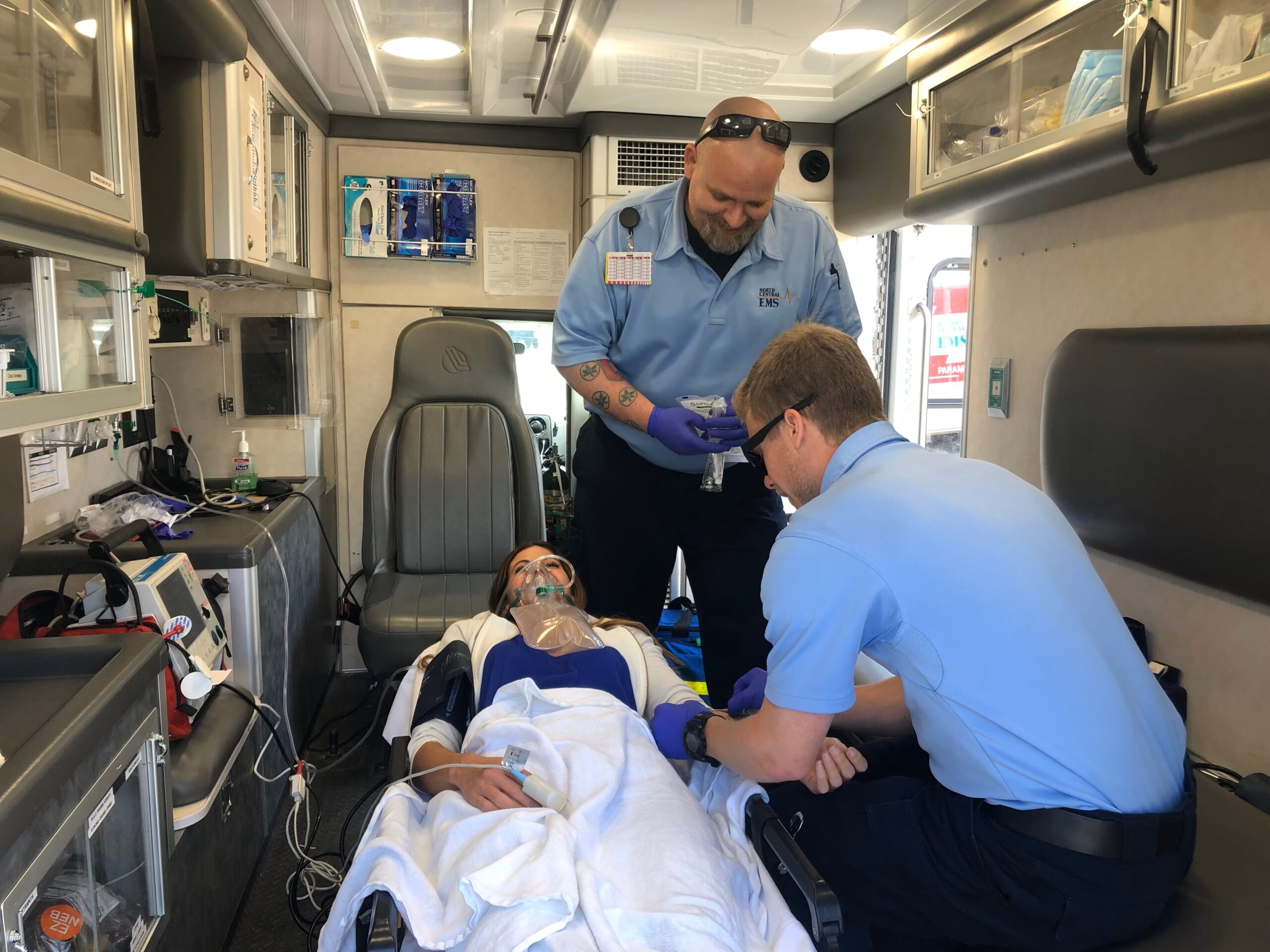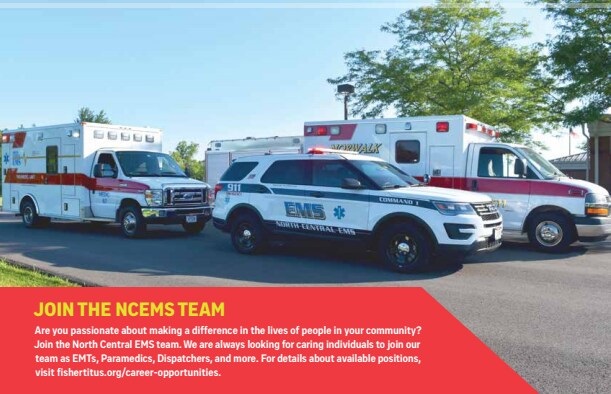In health care, we are often there through some of the most devastating times of our patients’ lives. Never has this been truer than over the past 2 ½ years of the COVID-19 pandemic. We are tired and heartbroken from caring for so many critically ill patients and sometimes even being with them in their last moments. This is especially difficult for us here at Fisher-Titus, since many of our patients are our neighbors, family, and friends from our tight-knit community. However, despite the exhaustion we feel dealing with sometimes devastating outcomes, the individualized, compassionate care we provide can leave a defining impact on patients’ families for years to come.
Read Viki Collins’ story about how our Fisher-Titus family made a positive impact on her family even as they grieved the loss of her husband, Dave.
Viki and Dave met while they were both volunteering for a local fire department where they lived in New York.
“Dave had this big heart that always saw the best in everyone,” Viki says. “He just always gave back. As soon as he turned 18 he started volunteering for the fire department.”
At the time they met, Viki was a basic EMT going back to school for advanced EMT critical care. She was a busy, single mom of her two sons, Logan and Liam when Dave asked her out on their first date.
“I said, ‘listen, I’m a single mom, I’m working full time, and I’m going to school, I don’t have time for you,’” Viki remembers with a laugh. “Even though we met volunteering, I was still very stingy with what I would give and do being a single mom. But Dave relit that fire for me – he reminded me that there was always something you could do and give back.”
But Dave persisted. He brought her coffee to work every day until he eventually won her over. They began dating in November, were engaged by March, and married the following October.
“We had a small wedding first and then and our Catholic ceremony later,” Viki explains. “Dave always joked that he loved me enough to marry me twice.”
Dave took on Viki’s two oldest boys as his own and they had two more boys, MJ and Stanley, together. They moved to Ohio and Viki has worked at Fisher-Titus for three years, now serving as Patient Access Supervisor.
Right after Thanksgiving 2021, Dave and Viki were both diagnosed with COVID-19. Soon after diagnosis, Dave was unable to keep his head up and was struggling to breathe so Viki took him to the Fisher-Titus Emergency Department.
“The ER staff was phenomenal,” Viki says. “Even though I couldn’t be in there with him, he was texting me, calling me, and keeping me updated.”
Unfortunately, Dave continued to get worse and was admitted to the hospital. He later was moved to the ICU before passing away on December 18.
Although Dave’s hospital stay did not end the way anyone would have hoped, Viki insists that the experience overall was positive thanks to the staff at Fisher-Titus.
“Obviously, I’d much rather have my husband home with me,” Viki explains. “But it wasn’t a bad outcome because of the hospital. Fisher-Titus really did everything they could to make it a positive experience and have a positive impact on our family.”
Viki remembers several instances where employees went above and beyond to support Dave and their family during his stay.
“After he was moved to the ICU, I walked in one day and the Safety & Security Liaison at the Pavilion was wearing a small, silver cross,” she describes. “I had asked where she got it from because Dave had wanted one. She was willing to take it off and give it to me. I didn’t take it—but she was willing to do that for us.”
Coming from health care, Viki understands more than most about what her husband was going through and was very involved in Dave’s care. She kept up through his patient portal and wanted to know everything that was going on even though she couldn’t always be there due to visitation restrictions.
“When he got to the floor, the nurses were very, very good,” Viki remembers. “Whenever I was there, they made a point to come into the room and talk to me. There was a time when something had happened when I wasn’t there and the nurse, Dalibor, called me to let me know. He started with ‘I want you to know, there’s nothing wrong’ before explaining what had happened and that they caught it immediately and fixed it. He was honest and up front and starting that way was huge for me.”
Viki expresses her gratitude for all of Dave’s caregivers taking the time to get to know him and his family.
“Theresa Stygles was the nurse practitioner with Pulmonary Medicine that was on Dave’s care,” Viki explains. “One day, she was rounding while I was visiting Dave and she wanted to know more about our story—how we met, who he was—she got to know him, so he wasn’t just a body in a bed. When I left the day he passed, she stopped and gave me a hug, and you could tell she was upset.”
She also had conversations with Dave’s doctors about what types of treatments they may be able to try. Given her background, she was familiar with what treatments were available and what successes other hospitals were seeing with various treatments.
“Every time I asked about something, they would respond with ‘I’ll look into it,’ ‘I’ll try,’ or ‘I’ll see what I can do but I make no promises,’” says Viki. “But nothing was ever off the table. I understood they were limited on what they could do but if it was something we could try, they were going to try it.”
Once Dave had been admitted into the ICU and was more seriously sick, Viki remembers the support and validation she felt from everyone she encountered.
“As with any long hospital stay, it wasn’t all rainbows and sunshine,” Viki says. “There were a couple of concerns I had along the way and I raised them—that was my husband—but the thing that was so nice, was that even when I was probably being a little unreasonable, not a single person treated me that way.”
Viki continues, “The nursing supervisor, the physicians, they understood that I was in a time of crisis and in survival mode myself. Even though I’ve been in the medical field forever, my brain was not there. They treated me with so much respect, validated my concerns, and explained what was going on in terms I understood.”
Eventually, Viki had to have some tough conversations and make some difficult decisions with his care team about how much intervention they would do.
“Even before Dave got to the point where we needed to stop care, I had a very long discussion with Dr. Alahmad and I had told him I was willing to do normal procedures that Dave may not have normally agreed to as long as I knew at the end of the day we were not prolonging his death. Dave and I were both in health care and we’d had the conversation that quality of life was more important than quantity,” Viki explains.
“At one point when Dave was in ICU, Dr. Alahmad called me, explained everything they were doing and said ‘We are doing everything medically we can, I’m going to pray for him,’” she remembers. “That might seem small, but I know everyone did everything they could and they would’ve fought as long as I asked them to.”
When the time came for Viki to have the tough conversation about stopping care, she recognizes the support she felt from his care team even then.
“Dr. Alahmad called me on the 18th and told me we were to that point we had talked about,” she remembers. “He said, ‘Anything else you want to try, I will arrange it and get him where he needs to be,’ but he said, ‘Viki we are prolonging his death at this point.’ That was all I needed to hear. He didn’t beat around the bush, and he didn’t give me false hope which is so important.”
Viki believes the care Dave received at Fisher-Titus was not something they would have found everywhere, adding that she doesn’t think it’s just because she’s an employee.
“I worked for another small hospital for over 10 years in New York. After leaving I said I’d never step foot to work in a hospital again—I didn’t believe they cared about their community,” Viki explained. “Even before everything with Dave, I had said ‘I don’t think I’ll ever leave Fisher-Titus.’ And this experience only strengthened that feeling. Everyone from housekeeping up through administration ‘walks the walk’ and cares for our patients with the understanding that we are caring for our community.”
Viki also recognizes that the understanding that our patients are our fellow community members leads to individualized care you may not find in other health care facilities.
“Obviously we’ve had to be restrictive with visitation due to COVID. However, the fact that we’ve allowed some visitation I think has made a huge impact.” Viki continues, “I also think we are so open to hearing feedback. The fact that Dave’s team was willing to go to administration and advocate for Dave and for me—everyone is so willing to consider individual circumstances and how policies may impact care. It goes back to them seeing the community and the individual, not just ‘this is what our policy is.’”
Viki says her experience has made the aftermath of losing her husband less challenging than one might expect.
“Because of the positive experience I had with Fisher-Titus, I feel like my grieving has been manageable,” Viki explains. “I had the communication with everyone at Fisher-Titus and I had that support so while it was a sudden loss, it wasn’t like it was a sudden loss and I was alone. Even when he was passing away, they came in and they checked him and then they told me to take all the time I need. They absolutely wanted to make sure I was in a good place.”
She recognizes that health care professionals are dealing with a lot due to the COVID-19 pandemic. But Viki says that despite that, staff continued to put their best foot forward for their patients and families.
“I know we are so burnt out in health care—it’s all of it over the past 2 ½ years—but even though I know those nurses are burnt out and tired, not once did they show it. Not once could you see it on their faces,” Viki remembers. “At the end of the day, I’m sure they went home and were exhausted. The ICU staff, the floor staff, and the ER staff—you never once saw that fatigue and that burn out.”
Viki wants Dave’s care team and every single Fisher-Titus employee to know the difference they make for their patients and their families.
“It was a crappy outcome, but a positive experience,” Viki states. “I really feel like from the people scrubbing the floors to the people scrubbing the claims and charges, everybody does a good job of making sure we support each other and put that best foot forward for the patient. The care Dave got was phenomenal and it has had a huge, positive impact on my family.”







